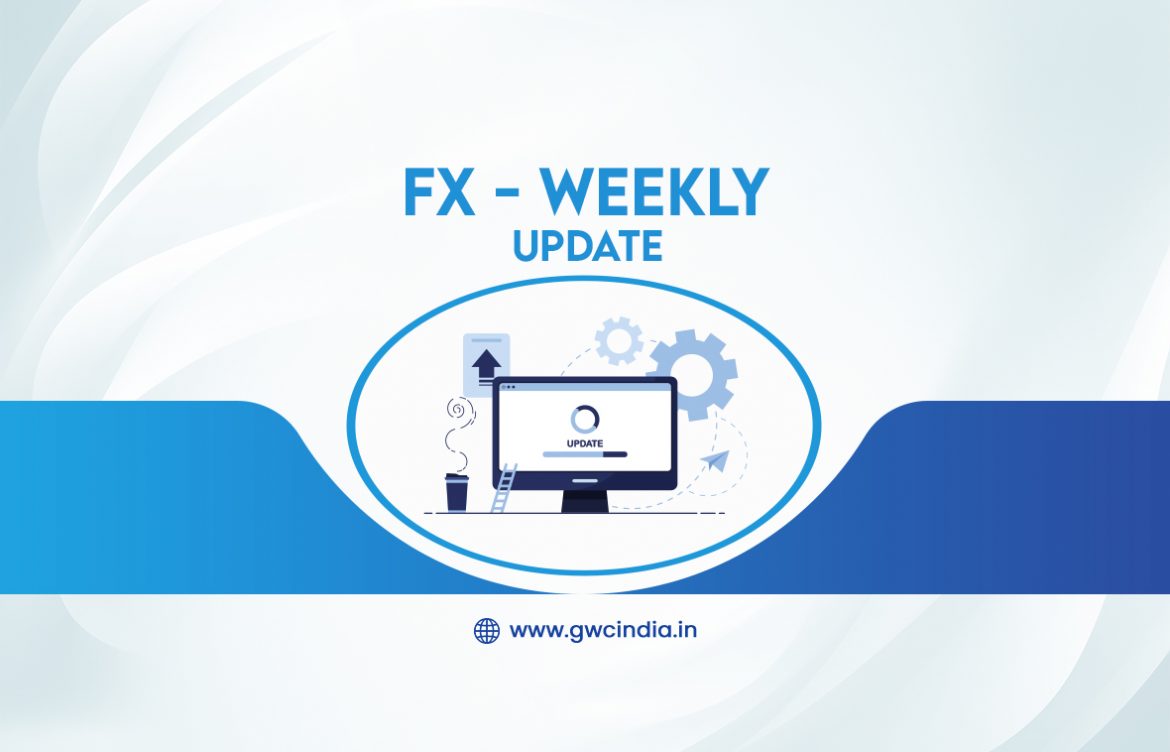FX – WEEKLY UPDATE :
FX Weekly Currency Score Week 51 of 2023
WEEKLY SYNOPSIS: 15/12/2023
Thank you for reading this post, don't forget to subscribe!Currency Map:
|
Currency Pairs |
WEEK CLOSE |
PRIOR WEEK CLOSE |
% change |
|
USD/INR |
83.02 |
83.38 |
-0.42 |
|
EUR/INR |
91.36 |
89.89 |
1.63 |
|
GBP/INR |
106.12 |
104.91 |
1.15 |
|
JPY/INR |
58.60 |
57.88 |
1.24 |
Brent Crude closed at USD 77 VS prior week close of USD 75.50. Gold closed at USD 2019. Nifty closed at 21456 vs prior week close of 20969. 10 Year G-SEC Yield closed at 7.19%.
Major developments: USDINR traded in the 82.94-83.43 range last week and closed at 83.02, loss of 36 ps for USD as compared to prior week close of 83.38. EUR climbed 1.63% w/w and GBP climbed 1.15 w/w against Rupee. Indian benchmark Equity index climbed 2.32% w/w. 10 Year G-SEC Yield closed at 7.19%. 1-year fwd premia is at 1.68% p.a.
FX reserves stood at USD 606.85 bn as on Dec 1 st. FX reserves climbed USD 2.81 bn. In Dec, FPI’S have bought Rs 32989 Cr of Equities and bought Rs 9027 Cr of debt . In 2022-23 fiscal year, FII’S have net sold Rs 27593 Cr of Equities and have net bought Rs 838 Cr of debt. On
It was a very interesting Friday as Rupee was allowed to gain on Corporate and FPI related inflows. Broad based USD gain against majors triggered withdrawal of import bids. RBI did not step in to buy USD. In the past few months, FPI’S have been investing heavily and RBI was stemming Rupee gains at 83.26. In a surprise development, RBI stepped aside and this led to sudden Rupee gains to 82.94.
Over the past few weeks, many positives have emerged for Rupee: 1) USD rates have peaked, 2) Crude Oil has been declining, 3) USD is still looking shaky against majors, 4) Heavy FPI inflows.
But for Chinese related worries, threat to Rupee seems to have dissipated.
Decline in US Yields has pushed USDINR fwd premia marginally higher with 1 year premia at 1.68%. Fwd premia could start climbing further as rate differentials favor Rupee over USD. Indian Equities continued to surge on strong IIP numbers and reports of increase in Private capex. With USD rates peaking, markets are enjoying with a breathtaking rally.
On macro data front, trade deficit fell sharply to USD 20.58 bn in Nov as against USD 31.46 bn in Oct. Imports declined to USD 54.48 bn in Nov from USD 65.03 bn in Oct. Exports rose marginally to USD 33.90 bn in Nov from USD 33.57 bn in Oct. in this fiscal, Indian exports is at USD 278.80 bn, down 6.5% y/y , while imports is at USD 445.15 bn, down 8.67% y/y. Meanwhile, services exports, too, has stood still in November at $28.69 billion compared to $28.70 billion in October, and imports fell to $13.40 billion from $14.32 billion in the previous month.
Indian CPI climbed 5.55% in Nov as against 4.87% in Oct. Food inflation rose to 8.7%. Headline inflation is within RBI band of 2 to 6%., IIP climbed 11.7%. Mfrg grew by 10.4%. Mining grew by 13.1% and power output rose 20.4%.
RBI has projected FY 24 inflation to average 5.4%.
Indian PMI(services) declined to 56.9 in Nov from 58.4 in Oct. PMI(mfrg) rose to 56 in Nov from 55.5 in Oct.
Based on the recent Global and Indian macro situation, expect USDINR to trade in the 82.60-83.35 range in coming weeks.
Hedging advise: Imports be hedged closer to 82.80/82.65. Exports be hedged closer to 83.25/83.35.
Global developments: Week was dominated by major Global Central banks rate decisions and statements. USD whipsawed after announcements. USD fell soon after Fed decision, but rebounded on Friday evening as NY Fed President quashed market expectations of March 2024 rate cuts.
Fed has removed rate hike scenario and has signaled that rate has peaked at 5.25-5.5% band. It is also now projecting three rate cuts next year, to 4.6%. This is against two rate cuts projected last time. Fed Chairman said that it is too premature to declare victory against inflation. However, he did not aggressively push back against rate cuts next year. As per Fed, Core PCE is expected to soften to 3.2% this year as against earlier projection of 3.7% and is further expected to drop to 2.4% next year. Unemployment is expected to be 4.1% for next year. GDP is expected to be 2.6% in this year and expected to soften to 1.4% next year.
NY Fed President quashed hopes of March 2024 rate cut. He emphasized Fed’s focus on determining if the current monetary policy is “sufficiently restrictive” to bring inflation back down to the 2% target. He also highlighted the unpredictable nature of economic data, suggesting Fed must be prepared to “tighten the policy further, if the progress of inflation were to stall or reverse.”
US 10 year yield declined to 3.95%. In mid Oct, it was above 5%. Market enthusiasm towards rate cut seems to be much ahead of the curve as US spending, labor market and services data are still strong. US Equities and Global Equities surged on the above developments.
BoE kept Bank Rate unchanged at 5.25%.BOE reiterated its stance that “monetary policy is likely to be restrictive for an extended period of time.” This suggests continued cautious approach towards easing monetary conditions, likely due to persistent inflationary pressures. The Bank further emphasized that “Further tightening in monetary policy would be required if there were evidence of more persistent inflationary pressures,” indicating readiness to adjust policy should inflation not moderate as expected.
ECB kept interest rates unchanged, maintaining the main refinancing rate at 4.50% and the deposit rate at 4.00%, as was widely anticipated. In a significant update, ECB substantially lowered its headline inflation forecast for 2024 from 3.2% to 2.7%. On the growth front, ECB’s projections indicate modest economic performance, with growth averaging 0.6% for 2023, 0.8% for 2024. ECB reiterated that the current interest rates are positioned to substantially contribute to bringing inflation back to its target, provided they are “maintained for a sufficiently long duration.” The ECB plans to continue following a “data-dependent approach” to determine the “level and duration” of policy restrictions.
ECB President in her post-meeting press conference, made it clear that the governing council did not discuss a rate cut in their meeting. She underlined the ECB’s vigilance, asserting the need to “keep our guard up” and closely monitor data to ascertain if the recent decline in inflation is sustainable.
ECB member said that rate hikes are over, but it is too premature to talk about rate cuts.
EU PMI Composite index decreased from 47.6 to 47.0. This ongoing contraction underscores the challenges facing the Eurozone economy, with a high likelihood that it has been in a recession since the third quarter.
UK PMI(composite) rose to 51.7 from 50.7, 6 months high. Chief Business Economist at S&P Global Market Intelligence, commented, “The UK economy continues to dodge recession, with growth picking up some momentum at the end of the year to suggest that GDP stagnated over the fourth quarter as a whole.” He also highlighted the dual-speed nature of the UK economy, with manufacturing contracting sharply while services, particularly financial services, showed signs of growth.
Based on the vacillating comments from Fed, ECB and BOE members, expect Cross Currency consolidation to happen with no two way clear movement till the path of rate differential becomes more certain.
Currency technical levels: USDINR: 82.80/82.65 (Supports), 83.25/83.40 (resistance),
EURINR:91.80(Resistance),89.
GBPINR: Supports: 104.20/103.40( supports), Resistance:106.50(Resistance).
JPYINR: Resistance:59, Supports: 57.45/56.45 (support).
Hedging advise: USDINR imports be hedged on decline to 82.80/82.60. EUR and GBP exports can be covered.


